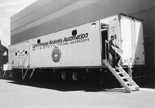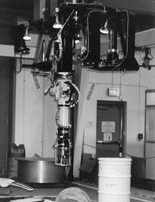
Trailer for sale or rent ...
Robotics Forum introduces environmental automated lab on wheels
 Participants at the sixth annual Industry/University/Laboratory Forum on Robotics kept leaving the meeting area to examine the contents of a trailer in the parking lot. One after another they blinked their way through the August Albuquerque sunlight to get a look at a lab staffed with robots, computers, and a few humans. Inside they saw a demonstration of an automated lab that pulled together all the analytical chemistry technologies needed to characterize a soil sample for organic contaminants such as polychlorinated biphenyls. Not only was the Contaminant Analysis Automation system on display for the first time, but a
Cooperative Research and Development Agreement for the system with barely dry signatures was announced at the first forum session. SciBus Analytical, Inc., a small business, will work with the
U.S. Department of Energy for five years beginning in 1996 to further develop CAA and commercialize it.
Participants at the sixth annual Industry/University/Laboratory Forum on Robotics kept leaving the meeting area to examine the contents of a trailer in the parking lot. One after another they blinked their way through the August Albuquerque sunlight to get a look at a lab staffed with robots, computers, and a few humans. Inside they saw a demonstration of an automated lab that pulled together all the analytical chemistry technologies needed to characterize a soil sample for organic contaminants such as polychlorinated biphenyls. Not only was the Contaminant Analysis Automation system on display for the first time, but a
Cooperative Research and Development Agreement for the system with barely dry signatures was announced at the first forum session. SciBus Analytical, Inc., a small business, will work with the
U.S. Department of Energy for five years beginning in 1996 to further develop CAA and commercialize it.
The CAA system combines recent technical breakthroughs in robotics, software controls, electrical engineering, and analytical chemistry to meet government and industry needs to identify pollutants. The program seeks to develop a new robotic analytical chemistry system and to design and transfer to industry automated instruments and systems based on the standardized modular architecture. The fully modular, or "plug and play" architecture allows chemical labs to assemble a customized system for automated sample preparation and analysis and data interpretation.
The CAA system consists of interchangeable modules, each designed to perform a combination of tasks such as measuring, filtering, or analyzing. The modules can be grouped together as required for specific analytical work, and interconnected by robotic arms that move samples between modules under the control of a central computer. The system should increase worker safety, reduce sample preparation time, and dramatically improve accuracy and precision.
DOE's Office of Technology Development is coordinating development of the CAA system by
Los Alamos,
Oak Ridge,
Sandia,
Pacific Northwest, and
Idaho National Engineering Laboratories and the Universities of Florida, Tennessee, and Texas. DOE and laboratory researchers believe the CAA system can become the industrial standard for chemical analysis. The goal is a system of standard laboratory modules that can meet U.S. Environmental Protection Agency specifications for most types of contaminant analysis.
"The labs have worked together on ways to reduce the estimated $230 billion cost of cleaning up the DOE weapons complex and on tools that can help solve the even greater problem of characterizing contaminated sites in the private sector," said Bob Hollen, project coordinator in Los Alamos' Engineering Sciences and Applications Division. "The Contaminant Analysis Automation system is our answer to the demand for a faster, cheaper, standardized, and reliable way to characterize a broad spectrum of contaminants."
Among potential applications of the automated system are characterization of soil and water samples or storage tank residues and development of standardized technology for the pharmaceutical, genetic, forensic, petroleum, chemical, and quality assurance industries.
The system won't be 100 percent automated. The laboratory manager will pull different modules off the shelf and plug them in as needed for a particular batch of samples, Hollen said. A chemist or trained technician must prepare the samples, and a technician must monitor the modules for a consistent supply of samples and supplies. Duplication of modules, redundant sensors, and software that connects the modules ensure each sample receives precisely the same analysis.
 Another part of the CAA system is a database or electronic notebook that provides a chain of custody and other legal requirements for decisions based on chemical analyses from the automated lab. The database stores raw and processed chemical analysis data and formats for transferring the data, aids in routine maintenance of the hardware, and provides access and documentation for the available analytical methods.
The second day of the Robotics Forum featured an open house at Sandia National Laboratories. Participants were able to watch robotic technology and software demonstrations and ask questions of the scientists, technicians, and students working on nearly 30 different projects.
Another part of the CAA system is a database or electronic notebook that provides a chain of custody and other legal requirements for decisions based on chemical analyses from the automated lab. The database stores raw and processed chemical analysis data and formats for transferring the data, aids in routine maintenance of the hardware, and provides access and documentation for the available analytical methods.
The second day of the Robotics Forum featured an open house at Sandia National Laboratories. Participants were able to watch robotic technology and software demonstrations and ask questions of the scientists, technicians, and students working on nearly 30 different projects.
For information about CAA via the Internet, use this address http://www.
sandia.gov/cc_at/1cc_at.html.
For information from SciBus, call (505) 667-8718 or send e-mail to ap@esa.lanl.gov.





 Participants at the sixth annual Industry/University/Laboratory Forum on Robotics kept leaving the meeting area to examine the contents of a trailer in the parking lot. One after another they blinked their way through the August Albuquerque sunlight to get a look at a lab staffed with robots, computers, and a few humans. Inside they saw a demonstration of an automated lab that pulled together all the analytical chemistry technologies needed to characterize a soil sample for organic contaminants such as polychlorinated biphenyls. Not only was the Contaminant Analysis Automation system on display for the first time, but a
Cooperative Research and Development Agreement for the system with barely dry signatures was announced at the first forum session. SciBus Analytical, Inc., a small business, will work with the
U.S. Department of Energy for five years beginning in 1996 to further develop CAA and commercialize it.
Participants at the sixth annual Industry/University/Laboratory Forum on Robotics kept leaving the meeting area to examine the contents of a trailer in the parking lot. One after another they blinked their way through the August Albuquerque sunlight to get a look at a lab staffed with robots, computers, and a few humans. Inside they saw a demonstration of an automated lab that pulled together all the analytical chemistry technologies needed to characterize a soil sample for organic contaminants such as polychlorinated biphenyls. Not only was the Contaminant Analysis Automation system on display for the first time, but a
Cooperative Research and Development Agreement for the system with barely dry signatures was announced at the first forum session. SciBus Analytical, Inc., a small business, will work with the
U.S. Department of Energy for five years beginning in 1996 to further develop CAA and commercialize it.

